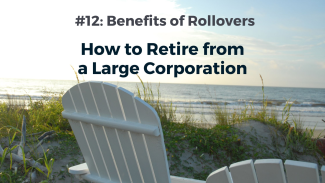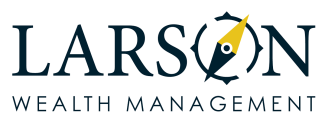
How to Retire from a Large Corporation #12: Benefits of Rollovers
Are you like many people we know in Harrisonburg and Rockingham County who are excited about their retirement years, but are overwhelmed by the complexity and all of the numbers in front of you? When should you draw Social Security? How much will healthcare cost? How much will you actually spend in retirement?
All these numbers are important and you should absolutely get a handle on them as you get closer to the date; but do not get overwhelmed with the complexity of the task. The goal is to stay focused on the big picture and break down your decisions into simple action items.
This blog is the 12th in a series, “How to Retire from a Large Corporation” and is designed to accompany an e-book by the same name.
In the last several blogs, we have covered explored pension survivor options, internal rates of return, and discussed several strategies to consider to help you make the best decision with your pension. Today, we will explore some of the reasons why many people decide to rollover their pension or 401(k) into an IRA.
Before we dig in, here is an important disclaimer required by our back office: A plan participant leaving an employer typically has four options (and may engage in a combination of these options), each choice offering advantages and disadvantages.:
- Leave the money in his/her former employer’s plan, if permitted;
- Roll over the assets to his/her new employer’s plan, if one is available and rollovers are permitted;
- Take a lifetime annuity check from company plan, if applicable
- Roll over to an IRA; or
- Cash out the account value.
The decision to rollover your pension can be a very wise decision, or it could be disastrous if not handled correctly. Below are some of the more common reasons why retirees choose to rollover their pension, and then we will explore some questions you should ask yourself and talk with your advisor about:
Here are a few of the benefits:
- By rolling the funds to an IRA, you have more control over when you claim the income, which opens up many tax planning strategies. For instance, many folks we meet who retire early can live off their savings and dividends in the early years of retirement, meaning their total tax bill can be very low for the first few retired years. This window can be a great time to convert traditional IRA money to Roth IRAs during this season where income is low. As of 2022, anyone can convert to a Roth, regardless of income, and the Roth money can grow tax-free for the remainder of your life. Tax rates may go up in the future, so you may want to elect to pay a little tax now instead of a potentially much larger tax bill later.
- Once you roll the funds to an IRA, you have the flexibility to invest them aggressively or conservatively, as is appropriate for your situation. This flexibility can allow for more growth long-term, or fund high-dollar short-term needs.
- You can leave the money to your kids. With the pension, there is generally no benefit after the death of the second spouse. If you roll the money to an IRA and invest the money wisely, there may still be funds for your kids after you are gone.
Because of this flexibility, many retirees assume a rollover is always the best option for them. However, this is not the case. Here are some questions to consider:
- What is your risk tolerance? Are you able to stomach the ups and downs of the market, and do you have confidence in the long-term prospects of the economy?
- How about longevity? Is this money meant to last you for the rest of your life, or do you have other income and assets to meet your living needs?
- What withdrawal rate will you need from this money? If you are planning on a high withdrawal rate from your rollover, then it may not last as long as you do.
The decision to take the company pension as a income stream or as a rollover may be one your most important retirement decisions. Choose wisely!
Check back next time as we explore how to organize your assets in terms of their tax status and make a plan to use them efficiently. Thank you for reading! To download the full “How to Retire from a Large Corporation” eBook you can find it here.
*Traditional IRA account owners have considerations to make before performing a Roth IRA conversion. These primarily include income tax consequences on the converted amount in the year of conversion, withdrawal limitations from a Roth IRA, and income limitations for future contributions to a Roth IRA. In addition, if you are required to take a required minimum distribution (RMD) in the year you convert, you must do so before converting to a Roth IRA." A Roth IRA offers tax deferral on any earnings in the account. Qualified withdrawals of earnings from the account are tax-free. Withdrawals of earnings prior to age 59 ½ or prior to the account being opened for 5 years, whichever is later, may result in a 10% IRS penalty tax. Limitations and restrictions may apply.
—-
This is the 12th of many blogs we are writing to help you finish strong in life. Much of the content is pulled from an eBook we wrote entitled “How to Retire from a Large Corporation.” Click here to download the document. If you would like to discuss any of these topics in more detail, you can schedule a time to talk through this link.

